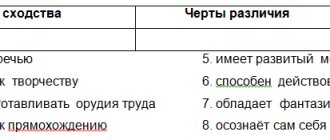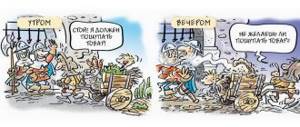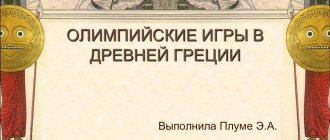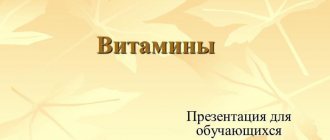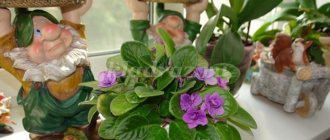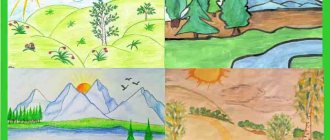Presentation for the lesson “Insects” for children of senior preschool age
Evgenia Vladimirovna Gorshkova
Presentation for the lesson “Insects” for children of senior preschool age
Slide 1
Presentation on the topic “INSECTS”
Slide 2
Insects live everywhere. In deserts and tropics, in the taiga and Antarctica.
Slide 3
Insects live in all environments - in the air, on land and in water.
Slide 4
The main signs of an insect. Six legs. Three parts of the body - head, chest, abdomen. In most cases, insects have Wings Head Thorax Abdomen.
Slide 5
Which of these animals is not an insect? It is believed that spiders are animals belonging to the phylum arthropods, the class of arachnids. They inhabit almost every corner of the planet. This type of predator feeds on insects, small animal species, and amphibians. The science that studies the life of spiders is called arachnology.
Slide 6
Insect feeding. What insects don't eat! Butterflies - nectar from flowers, cockroaches - bread, flies - meat, mosquitoes - blood.
Slide 7
The type of nutrition depends on the life stage. For example, a caterpillar larva feeds on leaves, and a butterfly feeds on nectar.
Slide 8
Insects defend themselves. To escape from enemies, insects have developed protective mechanisms: camouflage coloration; repellent coloration. Camouflage uniform. Use of poison.
Slide 9
Dragonfly. A blue airplane landed on a yellow dandelion?
Slide 10
The most voracious predators on the planet. Their prey weighs several times more than the insect itself. They fly very fast. Dragonflies have thirty thousand eyes, molded together on each side. The upper eyes distinguish only black and white colors, and the lower ones - all others.
Slide 11
Bee. The housewife will fly over the lawn, fuss over the flower - He will share the honey. The bee brings nectar into the hive, from which it makes honey. And as a building material it uses wax secreted by glands on the abdomen, and propolis (bee glue, which insects extract from plant buds.
Slide 12
A person breeds bees and uses the result of their labor - honey.
Slide 13
Domestic bees live in hives. Wild bees build nests in trees.
Slide 14
They “sing” using their wings and all have “ears” on their front legs. All grasshoppers jump well, pushing off with their legs, and descend slowly with the help of their wings. From a branch to a path, From a blade of grass to a blade of grass A spring jumps - A green back.
Slide 15
Ants. In the forest near the stump there is bustle and bustle: The working people are busy all day long. Ants live everywhere, from city apartments to Antarctica. Ants are practically omnivorous.
Slide 16
The structure of an anthill.
Slide 17
Firefly. Not the sun, not fire, but shining.
Slide 18
Wasp. Unlike bees, wasps do not store honey. Wasps often build nests in the ground. Like a tiger: mustache, striped, And the sting is sharper than a dagger. Buzzing, soared into the skies Sweet lover -...
Slide 19
Cockroach. Cockroaches eat almost everything. Regular food, books, leather clothes, even homemade flowers. Surprisingly hardy and tenacious. A cockroach may not eat anything for a whole month. Hides in corners, interferes with sleep at night, does not feed for weeks, What is the name of the pest?
Slide 20
Water strider. Lives on the surface of the water in the summer, under the bark, without fuss, whiles away the winter. The course of her long legs is a measure of the water surface. Who else could slide like that? Only…
Presentation “Insects” presentation for a lesson on the world around us (grade 3) on the topic
Slide 1
Insects Kravtsun M.G. MBOU ESOSH No. 1
Slide 2
Insects Insects are a class of arthropod invertebrate animals. Insects are different, their size varies from 0.2 mm to more than 35 cm. There are more than a million species of insects, they live all over the earth, from Antarctica to Antarctica. Some insects live less than 1 week, and some more than 15 years. Of all animals, insects make up approximately 91%, which is the vast majority.
Slide 3
Insects are animals that have three pairs of legs and the body is clearly divided into three parts: head, chest, abdomen.
Slide 4
Riddles about insects The flower had all four petals moving. I wanted to pick it - He took off and flew away. Butterfly
Slide 5
This little one is wearing a red polka dot dress. And she can fly deftly. This is... Ladybug
Slide 6
She buzzes over the flower, flies quickly towards the hive, gives her honey to the honeycomb, What is her name? ...Bee
Slide 7
Not an animal, not a bird - The nose is like a knitting needle. It flies - it squeaks, it sits - it is silent. Whoever kills him will shed his blood. Mosquito
Slide 8
In a green tailcoat, the maestro flies over the meadow in bloom. He is the pride of the local orchestra and the best high jumper. Grasshopper
Slide 9
Insects of the Rostov region MOL Moth is an insect that is a close relative of the butterfly. The moth is usually active at night and hides in its shelter during the day. Moths feed on a variety of foods: fur, wool, meat, fish, insects, felt, leather and dust. Moths cannot tolerate temperatures below zero, as well as the smell of orange peels and toilet soap. WASP Wasps are either social insects or solitary insects. Among the 17 thousand species of wasps, only 1500 are social. Wasps feed on liquids: nectar and flower juice. Wasps can sting, but they do this extremely rarely - solely for the purpose of self-defense. If you sit and don't move, the wasp won't touch you.
Slide 10
Cicada Cicadas are musical animals, each species producing a sound of its own pitch. Some entomologists can identify a cicada species by sound alone. Cicadas are excellent camouflages and are difficult to see with the naked eye. The main enemy of the cicada is the ground wasp. This insect is able to find a cicada without much difficulty. After this, the wasp stings the cicada and drags it to its home to feed on the larvae.
Slide 11
Firefly Fireflies are curious insects that can glow. There are a lot of fireflies - as many as 2 thousand species scattered throughout the world. In the dark, fireflies emit phosphorescent light: yellow-green spectrum zone, wavelength 500-650 nm. Many species of fireflies can create intermittent light or can “dim” their flashlight.
Slide 12
May beetle May beetles tell us that spring has come. Their buzzing can be heard in the first warm days of May. In theory, the cockchafer should not fly. Its flight is an exception to all laws of aerodynamics. The cockchafer cannot be imported into the United States because it has no natural enemies there. This means that the beetle can multiply and destroy all the vegetation of America.
Slide 13
Stag beetle Stag beetles are the largest beetles in Europe and Russia. They can reach a length of 10 centimeters. The stag beetle is listed in the Red Book; there are practically no representatives of this type of insect left in Europe, although they can still be found in Russia. The stag beetle does not eat food, it feeds only on tree sap. This beetle had the honorable share of becoming insect of the year 2012 in Germany, Austria and Switzerland.
Slide 14
Mantis Mantises are funny insects belonging to the order Cockroaches. Mantises have only one ear, but it hears perfectly. Mantises are masters of camouflage. This animal is almost impossible to find in the wild. Praying mantises feed on small lizards, snakes, and toads. If he really wants to eat, he can also eat his “relative” - another mantis.
Slide 15
Bedbug Bedbugs are the well-known “stinkers” from the world of insects. Bedbugs can smell human sweat at a distance of about 9-12 meters. An adult bedbug can live without food for about 500 days. Bedbugs are resistant - they get used to toxic substances, and the next generation of bedbugs will no longer be affected by the poison.
Slide 16
Butterfly Mantis Mantises are funny insects belonging to the order Cockroaches. Mantises have only one ear, but it hears perfectly. Mantises are masters of camouflage. This animal is almost impossible to find in the wild. Praying mantises feed on small lizards, snakes, and toads. If he really wants to eat, he can also eat his “relative” - another mantis. Butterflies are representatives of the group of lepidopteran insects. Butterflies are excellent pollinators; they are surpassed in numbers only by bees. Butterflies can fly at a speed of 15 kilometers per hour, although some species can accelerate up to 50 kilometers per hour. A butterfly has a life cycle: an egg turns into a caterpillar, which turns into a pupa and, accordingly, into a butterfly. Butterflies never sleep.
Slide 17
Bee Cricket To get 30 grams of honey (one spoon), 400 bees work all day. If a bee finds food not far from the apiary, then it dances a “circular” dance, informing its “colleagues” about it. A bee swarm is usually about 50-60 thousand bees. In total, in such a swarm, bees can bring about 2 kilograms of honey at a time. These insects store honey in their crops. Crickets are small insects that resemble grasshoppers. Crickets can copulate about 50 times within 3 hours with the same female - this is a record in the animal world. The frequency of cricket chirping depends on the air temperature. To find out how many degrees there are outside, you need to count the number of sounds in 25 seconds, divide this number by 3 and add 4 to the result. This way we will get the exact temperature in degrees Celsius. This method only works in warm weather.
Slide 18
Ladybug Ant Ladybug is a very cute bug with bright colors. There are more than 5,000 species of ladybugs in the world. Ladybugs come in different colors: yellow, red, pink, black and white. The older the bug is, the fewer black dots it has on its back. Ladybugs can disguise themselves as dead people to escape their enemies. If this option is not suitable, then they secrete an orange liquid that scares away predators. Ants are highly organized insects whose unusual, intelligent-like behavior has attracted the attention of scientists for many years. Ants are capable of self-sacrifice for the sake of the colony; they can organize multi-stage actions and know how to adapt to conditions. There are about a million ants per person. Just imagine how many there are around the world!
Slide 19
Colorado potato beetle mosquito The Colorado potato beetle is the most famous pest beetle that damages potatoes, tomatoes, eggplants, peppers and other crops carefully grown by humans. The size of the beetles is about 1 centimeter in length. Colorado beetles, as we have already said, feed on young leaves of plants and settle next to the beds. Mosquitoes are small insects that are well known to every person. Mosquitoes have several unusual features: for example, a female mosquito lives twice as long as a male. In addition, exclusively females also suck blood - they are looking for food that will help feed future offspring. The nasty squeak of a mosquito that we often hear is the result of the flapping of the wings of these insects. And mosquitoes bite more often than sweaty people; they are attracted by the unique smell of a person combined with the smell of sweat
Slide 20
Love your native nature - Lakes, forests and fields. After all, this is our forever native land. You and I were born on it. You and I live on it. So let's all people together treat her kinder.
Game for 7th grade schoolchildren with a presentation on the topic: Insects
Game lesson script.
Lesson-summarization on the topic “Insects Class” Author: Tatyana Vladimirovna Karpenko, biology teacher, Secondary School No. 59, Novosibirsk Purpose of the game: to generalize, systematize and expand knowledge about insects and their diversity. “Amazing six-legged planets” Conducted as an extracurricular activity or as a general lesson. The task is given in advance to draw a background and the name of the squad on A2 paper. For example: Lepidoptera, Beetles, Bugs, Dragonflies, Diptera, Hymenoptera, etc.
Task No. 1. Gather your squad of insects based on their characteristics. We cut this text into strips, mix and distribute to children.
Each student receives a text that talks about an insect. Assignment: identify a squad and find “squad mates” (children move freely around the class, are assigned to groups and stand at the table with the corresponding picture). After the teacher checks the correctly identified group, everyone’s text is pasted onto the poster, and the team receives points. An order of insects with complete metamorphosis, the most characteristic feature of whose representatives is the presence of a thick cover of chitinous scales (flattened hairs) on the front and hind wings.
Most species are characterized by a specialized sucking mouthparts with a proboscis. The shape and wingspan are very diverse: from 2 mm to 30 cm Development with complete metamorphosis: there are stages of egg, larva (called caterpillar), pupa and adult. The larva is worm-like, with underdeveloped abdominal legs, powerful integument of the head, gnawing mouthparts and paired glands, secretions from which, when in contact with air, form a silk thread. The commonly used Russian name for representatives of this order is “old woman, grandmother” and these insects are thought of as the souls of the dead. To this day, in many villages and hamlets they are called “grandmother”, “grandmother”, “grandmother”, “baburka”, “grandmother”. The word “moth,” according to one version, is a derivative of “grind” (then the etymological meaning of the word is “crushing (damaging) insect”) There is hardly a person in the world who would not admire them in the same way as beautiful flowers are admired. It was not for nothing that in ancient Rome they believed that these insects originated from flowers torn from plants. There are hobbyists in all corners of the world who collect them with no less passion than other collectors collect works of art. The beauty of insects is in their wings, in their various colors. At the same time, the wings are the most important systematic feature of the order: they are covered with scales, the structure and arrangement of which determine the bizarreness of the color. Scales are modified hairs. An order of insects with complete metamorphosis. A distinctive feature of the order is the presence of only one front pair of wings. Their posterior pair is transformed into club-shaped organs of balance - halteres. Found everywhere, including Antarctica. Many bloodsucking animals are carriers of infectious diseases (malaria, yellow fever, etc.). However, at the same time, they are of great importance for agriculture, since they are pollinators of various plants, including cultivated ones. They are characterized by forward-motority - they use only the front pair of wings for flight. The rear pair of wings is transformed into organs of balance. Some, mostly parasitic forms, may lack wings. The main features are the preservation in the adult stage of only the first pair of wings—the organs of rapid and perfect flight; the metathorax wings are transformed into halteres. They serve as a balancing organ. The structure of the legs is closely related to their lifestyle. Agile, fast runners have short, strong legs. Others, usually hiding among the vegetation during the day, have long limbs adapted for climbing among the tangle of grass stems or in the foliage of trees and shrubs. The paws of the legs end in claws, at the base of which 2-3 special suction pads are attached. With their help, these insects can move freely on a completely smooth surface. Ingenious experiments have proven that in these insects the pads on their feet serve not only for movement, but are additional taste organs that signal the edibility of the substrate on which the insect sits. The distinctive features of this order include: of the two pairs of wings, the hind ones are smaller than the front ones, the wings have a sparse network of veins, rarely without veins (there are also wingless forms), on the anterior edge of the hind wing there is a number of hook-shaped hooks included in the corresponding fold on the posterior edge forewing, gnawing and licking or only gnawing mouthparts and complete transformation. The rear pair of wings is smaller and has a subordinate importance during flight. In living insects, both pairs of wings are usually attached to each other using hooks and work as one plane. Some species (workers and some insects) do not have wings. The size varies from 0.2 mm to 135 mm, but is usually less than 20 mm. The economic importance of these insects is great and varied. First of all, it should be said about one of the few domestic insects that has long provided humans with honey, wax and bee glue. But now it has become known that this insect brings the greatest benefit by pollinating cultivated plants. Many wild bees are also important pollinators. In recent years, another insect, bumblebees, has begun to be domesticated, and they are bred precisely to pollinate red clover. The leading place in the biological control method is occupied by insects of this order. Suffice it to say that in 80 well-studied cases, when the import and use of natural enemies of harmful insects led to the fact that the danger of mass reproduction of these pests was completely eliminated. These are terrestrial or aquatic insects, whose bodies are most often moderately flattened. The main characteristic of these insects is the piercing-sucking type of mouthparts; the proboscis in almost all cases is attached to the front of the head and a triangular shield on the back. The intermediate stage between egg and adult is called nymph. The lifestyle of these insects is very diverse, they are herbivores (suck the juices of various parts of the plant), parasites of mammals and birds, mycophages (feed on fungi), predators (hunt small invertebrates), live in spider webs, and also live in and on water. surfaces; some species are even found in the open ocean. They are limited only by their ability to penetrate into wood tissue and parasitize inside a living organism. They have a piercing-sucking proboscis that extends from the anterior edge of the head. The wings are folded flat on the back, their base is rigid, and the apex is membranous. Depending on their lifestyle, their legs are running, walking, swimming, as well as digging and grasping. The mesothorax is the most massive, forming a triangular shield on top. The openings of the odorous glands open on the metathorax of these insects. Their unique smell is familiar to everyone. The secretion of the odorous glands serves to scare off enemies and attract individuals of the opposite sex. Predatory and aquatic insects of this order do not have scent glands. Their eggs look like a barrel with a lid. The transformation is incomplete, the larvae are similar to the imago and from the 3rd instar acquire the rudiments of wings. Unlike adults, they do not have simple ocelli, and the openings of the scent glands open on the dorsal side of the abdomen with three unpaired openings. The larvae go through several instars and develop from several weeks to two years. Most feed by sucking plant juices; many species cause great harm. In addition, they can carry viruses that cause plant diseases. Many are predators, and some have become parasites, and are associated with birds, mammals, and bats. Insects are characterized by a slender, elongated, sometimes brightly colored or shiny body, a large head well separated from it, most of the surface of which is made up of huge eyes. Most insects fly during the day during the hottest hours. There are especially many of them along the banks of reservoirs, but often whole flocks of them rush along the edges of the forest. On the fly, they catch their prey - mosquitoes, real blood-sucking mosquitoes and other small insects. If you bend their lower lip with a pin and spread their jaws, you can see what a huge mouth these voracious predators have! Active during the warm part of the day, in the sun. The larvae of these insects develop in water. The larvae are active predators, attacking small aquatic animals, mainly insects. The larvae have a mask with which they can feed. These insects are one of the oldest insects on our planet: they are 330 million years old. They appeared at the beginning of the Carboniferous period, that is, long before the dinosaurs. When they appeared, there were no flying pterodactyl lizards, no birds, no bats on Earth. These were the only flying predators, gigantic, with a wingspan of up to 70 cm. Many are very sensitive to water pollution and can serve as a kind of indicators of the cleanliness of a reservoir. These include representatives living in fast-flowing waters - beauties, fatima, common dedka, ringed mace-bellied. Among the 800,000 species of insects, these insects are true masters of flight. On warm summer days they can soar over a pond for hours, making almost no movements of their wings. Having seen the prey, they unerringly grab it in a lightning-fast turn. By flapping their wings 30 times per second, they produce noise that is not perceptible to the human ear and use their wings as solar panels. Task 2. “Did you know?” (quiz) 1 point per correct answer 1. What is entomology? (science of insects) 2. Who appears earlier in the spring - bats or flying insects? (flying insects) 3. Which beetle is named after the month in which it appears? (Chafer beetle) 4. What beetles got their name from famous large mammals? (stag beetle) 5. What is myrmicology? (science of ants) 6. How can you tell when rain is coming by watching an anthill? (ants cover all passages and exits). 7. Which order does the clothes moth belong to? (lepidoptera) 8. Who did the swan princess turn Prince Guidon into in “The Tale of Tsar Saltan” by A.S. Pushkin? (mosquito, fly, bumblebee). 9. One of Thumbelina’s suitors, also an insect. (chafer bug) 10. Remember the most popular book about insects - it begins with a name day and ends with a wedding. (Fly-Tsokotukha) 11. From what work is the line and about whom are we talking: “The evil insect looks so menacing that bears, dogs, wolves, hippos and elephants are afraid of it”? (“Cockroach” K.I. Chukovsky Task 3. “General characteristics” The team must add the general characteristics of the Insect Class.
team ________________________________ 1. Insects are one of the classes in the type ________________________________ 2. There are more than 1 million species. They take first place in ___________. 3. Habitat - ________________________________. 4. Parts of the body - ________________________________. 5. Number of walking legs - ________________________________. 6. Presence of wings - ________________________________ 7. Organs of vision - ________________________________. 8. Skeleton - ________________________________. 9. Circulatory system - _________________ heart_______________ , instead of blood ___________________ 10. Respiratory system - ________________________________ 11. Digestive system -________________________________ 12. Excretory system - ________________________________ 13. Features of reproduction ________________, fertilization - __________ 14. Development ____________ and ________________________________ 15. Role in nature -________________________________ 16. Significance in human life - ________________________________
Task 4. “Who is, who” Distribute the insects into orders.
smoothie, filly, Apollo, gadfly, cricket, swimmer, silkworm, goliath, horsefly, ladybug, mosquito, mole cricket, bee, rider, bumblebee, admiral, water strider, harmful turtle, lemongrass, grasshopper, scarab.
Answers: 1. The filly, the cricket, the mole cricket, and the grasshopper are orthoptera. 2. Horseflies, gadflies, mosquitoes, bloodsuckers are dipterans. 3. Swimming beetle, goliath, scarab, ladybug - beetles (Coleoptera). 4. Bee, sawfly, rider, bumblebee are Hymenoptera. 5. Shield bug, water strider, smoothie, harmful turtle - bugs (hemiptera). 6. Lemongrass, admiral, Apollo, silkworm - butterflies (lepidoptera). Task 5. “The third odd one” For our next competition, you must first make up the name of the insect, then determine which of the 3 representatives is odd and why?
(max 2 points, if you made up and determined who is superfluous and why - 2 points, if you just made up - 1 point). 1 gr.
1. Sorrow, vumraye, apernzi. Bee, ant - hymenoptera, reptile butterfly. 2. Shva, oblha, obbakach. Lice, parasitic fleas, non-parasitic butterfly 2 gr. 1. Amkor, olkp, ahmu. Mosquito, bedbug - mouth.ap. piercing-sucking, fly - licking. 2. obbakach, uchkzinke, aarktan. Butterfly, cockroach - complete transformation, grasshopper - incomplete 3 g. 1. Lachpe, roshlekpdya, krsteoaz. The bee, silkworm are domesticated, the dragonfly is not domesticated. 2. Pseeln, dovo, rubyema. Horseflies, gadflies are dipterans, ants are hymenopterans. Task No. 6. Determine the name of the insect from the photograph, which order does it belong to? Fill out the table.
The image has been reduced. Click to see original.
Table
Answers: 1. berry bug, 2. Cabbage white bug, 3. Bed bug, 4. Rhinoceros beetle, 5. Dragonfly, 6. Dung fly, 7. Red ant, 8. May beetle, 9. Soldier bug, 10. Wasp, 11. Swallowtail butterfly, 12. Gadfly, 13. Green grasshopper, 14. Bronze beetle, 15. Common mosquito Summing up .
Grading. Download Game Lesson Script. Summary lesson on the topic “Class Insects”
We recommend watching:
Biology game for grades 6-7 “These wonderful animals” Extracurricular biology event for Bird Day, grades 5-7 Brain-ring in biology for high school students Didactic game in biology with your own hands. Biological lotto
Similar articles:
Botany game 6th grade with answers
Game - competition about birds for schoolchildren, grades 6-7
Biology role play, grade 7
Game “What? Where? When?" in biology, grades 9-11
Biology crosswords for grade 5 with answers and questions
